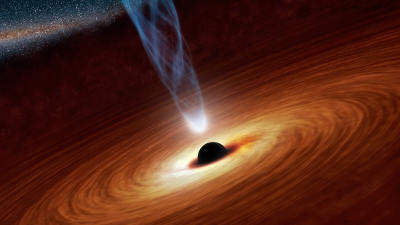Using AI to control energy for indoor agriculture
30 September 2024
Published online 1 June 2016
Quantum mechanics could claw back ‘information loss’ in the equations describing black holes.

© NASA/JPL-Caltech
Another puzzle arising from the combination of GR and QM is the so-called information loss paradox.
Because black holes cause physical states to devolve into one, they violate the intuitive QM assumption that the complete state of a system at one time must determine its state at another, nearby time.
Researchers eventually hope to establish a theory of ‘quantum gravity’ that could reconcile GR and QM. In a recent paper1, Ahmed Farag Ali at Benha University and Mohammed Khalil at Alexandria University in Egypt investigated a new route to solving some black hole problems including the information loss paradox. Specifically, they used a quantum version of the Raychaudhuri equation, which explains gravity by predicting the motion of nearby bits of matter.
Traditionally, the Raychaudhuri equation describes how an object bends space, causing other objects to follow certain trajectories. At a singularity, all these trajectories meet at one infinitely narrow point, presenting the problem for QM.
“Our work was inspired by a paper by Saurya Das2 in which he computed quantum corrections to the Raychaudhuri equation and showed that they prevent focusing of trajectories, therefore avoiding a singularity” says Farag Ali. He and Khalil used Das’ new quantum Raychaudhuri equation (QRE) to derive a new solution of Einstein’s field equations for the gravitational field around a spherical mass, and to calculate the quantum-corrected black hole thermodynamics.
The simulations predicted no emission of Hawking radiation, the usual predicted route by which black holes lose mass and energy. In other words, the quantum corrections prevent black holes from evaporating completely, just like QM prevents the hydrogen atom from collapsing in on itself.
Most surprisingly, the researchers found that their calculations changed the fundamental configuration of time and space dimensions within the black hole. “The quantum corrections turn the ‘spacelike’ black hole singularity to be ‘timelike’”, says Khalil. “This means it could be possible for information to get out of the black hole, hence resolving the information loss problem.”
Joan Simón at the University of Edinburgh, UK, who studies black holes in the context of string theory, believes that, although Farag Ali and Khalil’s work is speculative, it is a thorough exploration of how QM and GR may interact to produce new physics in the extreme regimes of black holes.
“It is a formidable quest to understand whether quantum mechanics helps us to understand the physics that replace space and time in singularities,” says Simón. “Farag Ali and Khalil explore this in a very specific way; instead of quantising the gravitational field, they solve the QRE for the geometry of space and time. They discover modified black hole solutions which still have singularities, but with the property of not being ‘felt’ by particles.”
The authors of this work are from Department of Physics, Faculty of Science, Benha University, Benha 13518, Egypt; Department of Electrical Engineering, Alexandria University, Alexandria 12544, Egypt.
doi:10.1038/nmiddleeast.2016.83
Stay connected: